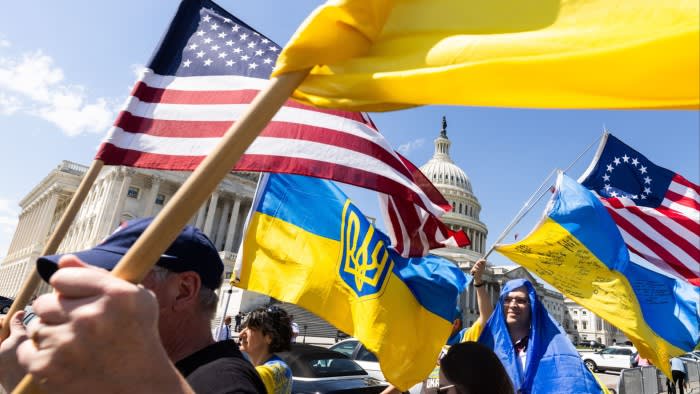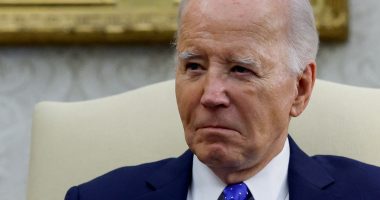
Stay informed with free updates
Simply sign up to the Geopolitics myFT Digest — delivered directly to your inbox.
After many months of argument and hesitation, the House of Representatives has finally acted. The vote in Washington to provide $61bn in new military aid for Ukraine may be a turning point in the war with Russia. At the very least, it will keep Ukraine in the fight.
The Russians will continue to hope that, if Donald Trump is elected president this November, this might be the last big package of American military aid. But even that might not be fatal to the Ukrainian cause. Europe’s military industries are belatedly cranking into action and will be in a better position to supply Ukraine in 2025.
The vote to provide extra money for Ukraine went through the House, alongside separate votes providing substantial aid for Israel and Taiwan. Together they offer a clear sense of how America — and its key allies in Europe and Asia — now see the world.
Collectively all of this money is intended to push back against four countries that General Chris Cavoli, the commander of US forces in Europe, describes as an “axis of adversaries”: Russia, China, Iran and North Korea.
Talk of an axis brings back unfortunate memories of 2002 and George W Bush’s “axis of evil”, which seriously overplayed the connections between Iraq, Iran and North Korea. But, two decades on, there is much harder evidence of serious military co-operation between Moscow, Beijing, Tehran and Pyongyang.
The US charges that China is supplying Russia with engines for drones, machines for cruise missiles and other forms of military aid. The regimes in Pyongyang and Tehran have become vital suppliers of weaponry for Moscow. China also recently proclaimed its “deep friendship” with North Korea, and dispatched a very senior official to Pyongyang for talks.
As these four autocracies pull closer together, so America’s democratic allies are also tightening their links. In Washington, the US and Japan recently announced a raft of new agreements that will take their security partnership to a new level. South Korea is also a major supplier of weapons for Ukraine.
The “western alliance” is now, in reality, a global network of allies that sees itself as engaged in a series of linked regional struggles. Russia is the key adversary in Europe. Iran is the most disruptive power in the Middle East. North Korea is a constant danger in Asia. China’s behaviour and rhetoric are becoming more aggressive, and it can marshal resources that are not available to Moscow or Tehran.
Of course, there remain important distinctions between these countries. Russia, Iran and North Korea are treated as pariah nations by the US and its allies. By contrast, China remains a major trading partner of all the countries of the “global west”.
In Washington and Tokyo, however, the acting assumption is that, in the long run, Xi Jinping is just as determined as Vladimir Putin or Ayatollah Ali Khamenei to overturn the current world order. The Japanese, like the Americans, think that what happens in Ukraine will have a vital bearing on what happens in the Indo-Pacific.
The US and its allies believe therefore that they are playing defence by supporting countries that are in the line of fire of the axis of adversaries — above all, Ukraine, Israel and Taiwan.
Strengthening military support for these countries has attracted criticism across the political spectrum. The isolationist right in the US remains bitterly opposed to aiding Ukraine. The progressive left accuses the US of supporting Israeli “genocide” in Gaza.
Even some who support the aspiration to defend the current global power structure worry about the strategy. The late Henry Kissinger was concerned that American support for Ukraine was driving Russia into the arms of China. Others believe that America simply lacks the military and economic resources to lead the pushback against adversaries in Asia, Europe and the Middle East simultaneously.
There may be some truth in that. A senior Biden administration aide concedes that “we’re pretty maxed out at the moment”. But the Americans and their allies also know that their adversaries have huge difficulties. Russia has sustained hundreds of thousands of casualties in its war with Ukraine. The Chinese economy is struggling. Iran faces internal unrest and North Korea is a nuclear-armed basket case.
Washington is also grappling with how to strengthen deterrence without getting the US directly involved in a war with any of the axis of adversaries. In practice, this has often meant providing America’s frontline allies with new military aid, while simultaneously trying to restrain their actions.
Throughout the Ukraine war, the US has tried to discourage Ukraine from striking deep inside Russia. After Iran fired a barrage of missiles at Israel this month, the US also moved to stop the conflict escalating further.
And even as the US provides extra political and military support to Taiwan, it has insisted that Taiwan must not provoke Beijing by taking overt steps towards formal political independence from China.
America is playing a potentially deadly mind game with its adversaries, deploying military force selectively, in the hope of preventing the outbreak of a wider war. Ukraine is fighting for its own freedom and independence. But it is also the frontline in what is potentially a much larger conflict.
Read More: World News | Entertainment News | Celeb News
FT







